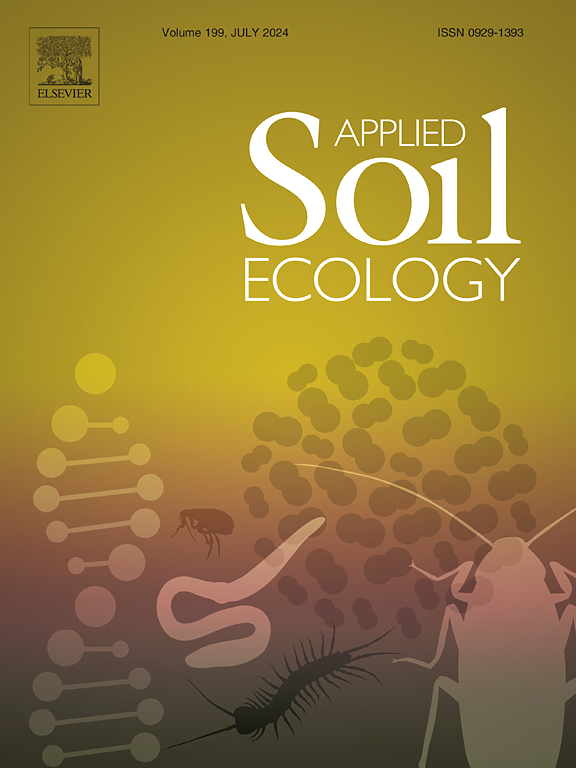紫色土壤施氮肥后土壤一氧化二氮排放量增加的微生物介导机制
IF 4.8
2区 农林科学
Q1 SOIL SCIENCE
引用次数: 0
摘要
土壤中的氧化亚氮(N2O)来源于多个过程,而氮肥往往会增加 N2O 的排放。然而,长期施用氮肥的紫色土壤中产生氧化亚氮的主要过程、主要微生物类群的贡献以及潜在机制尚不清楚。我们利用元基因组学技术和选择性抑制试验进行了为期两年的田间施肥试验,研究了在 0、180 和 360 kg N ha-1 yr-1 施肥水平下 N2O 排放的潜在机制。在该研究中,氮肥增加了土壤 N2O 排放量和排放因子(EF),累积 N2O 排放量和排放因子的范围分别为 0.13-3.47 kg N2O-N ha-1 yr-1 和 0.47-0.91%。同时,室内培养试验表明,氮肥主要促进氨氧化细菌(AOB)和反硝化过程产生 N2O,但减少了氨氧化古细菌(AOA)和完全氨氧化剂(comammox)产生的 N2O。通过影响土壤NH4+-N、NO2--N、AOB、亚硝化细菌和nosZ的丰度,长期施氮间接影响了N2O的排放。此外,施用氮肥后,NO2--N 浓度的累积以及 AOB、nirK、norB 和亚硝化细菌丰度的增加表明,硝化细菌反硝化作用(ND)也可能有助于 N2O 的形成。这些发现表明,AOB 驱动的硝化和/或 ND 可能是紫色土壤施氮后 N2O 排放增加的主要机制。本文章由计算机程序翻译,如有差异,请以英文原文为准。
Microbially mediated mechanisms underlie the increased soil N2O emissions under nitrogen fertilization in purple soil
Soil nitrous oxide (N2O) originates from multiple processes, and nitrogen (N) fertilizer often increases N2O emissions. However, the dominant processes, the contributions of major microbial taxa, and the potential mechanisms of N2O production in purple soil with long-term N application are unclear. We conducted a 2-year field fertilization experiment, utilizing metagenomic techniques and selective inhibition tests, to investigate the potential mechanisms of N2O emissions under 0, 180, and 360 kg N ha−1 yr−1 fertilization levels. In this study, N fertilizer increased soil N2O emissions and emission factor (EF), with the range of cumulative N2O emissions and EF being 0.13–3.47 kg N2O-N ha−1 yr−1 and 0.47–0.91 %, respectively. Meanwhile, indoor culture tests revealed that N fertilizer mainly promoted N2O production driven by ammonia-oxidizing bacteria (AOB) and the denitrification process, but decreased N2O production driven by ammonia-oxidizing archaea (AOA) and complete ammonia oxidizers (comammox). By influencing soil NH4+-N, NO2−-N, AOB, Nitrosospira, and nosZ abundance, long-term N application indirectly impacted N2O emissions. In addition, the accumulated NO2−-N concentration and the increased AOB, nirK, norB, and Nitrosospira abundance following N application suggested that nitrifier denitrification (ND) may also contribute to the formation of N2O. These findings suggest that AOB-driven nitrification and/or ND may be the main mechanisms for the increased N2O emissions after N application in purple soil.
求助全文
通过发布文献求助,成功后即可免费获取论文全文。
去求助
来源期刊

Applied Soil Ecology
农林科学-土壤科学
CiteScore
9.70
自引率
4.20%
发文量
363
审稿时长
5.3 months
期刊介绍:
Applied Soil Ecology addresses the role of soil organisms and their interactions in relation to: sustainability and productivity, nutrient cycling and other soil processes, the maintenance of soil functions, the impact of human activities on soil ecosystems and bio(techno)logical control of soil-inhabiting pests, diseases and weeds.
 求助内容:
求助内容: 应助结果提醒方式:
应助结果提醒方式:


